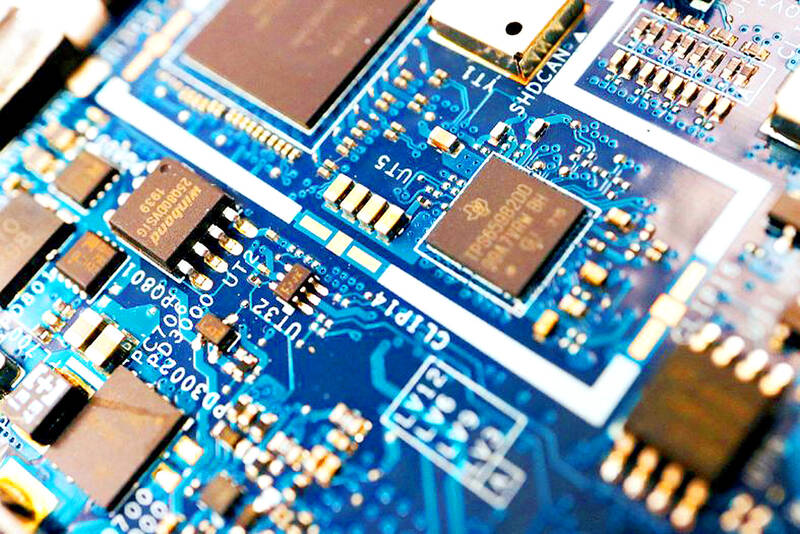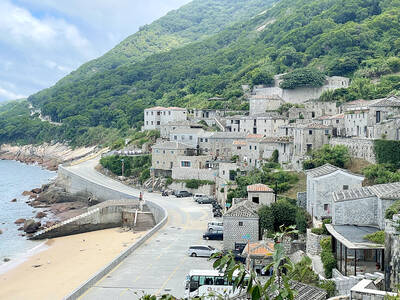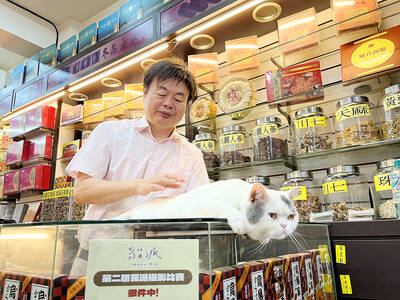Taiwan’s tech sector would likely avoid the worst effects of US President Donald Trump’s latest tariff threat, although the full impact is still unclear as there are no concrete details yet, two academics said.
“Whatever countries charge the United States of America, we will charge them. No more, no less,” Trump said when he announced plans to hit exports from countries that he said have trade policies that are unfair to the US.
US secretary of commerce nominee Howard Lutnick said that individual country reviews would be completed by the beginning of April, while a White House official said that action could be implemented within a few weeks.

Photo: Reuters
East-West Center in Washington adjunct fellow Chiang Min-hua (江敏華) said it is hard to gauge the impact of the tariffs, because it is unclear how they are to be calculated.
Under a product-to-product tariff system, if Taiwan imposes tariffs on US information and communications technology, the US would implement the same levy, she said.
Meanwhile, an average value tariff system would mean that Washington would apply a flat rate to all Taiwanese imports, based on the average tariff Taipei imposes on US goods, she added.
Trump’s tariff policy aligns with the promises he made during his presidential campaign to cut taxes and reduce the federal government’s budget deficit by using revenue from tariffs to offset the shortfall, Chiang said.
However, tariffs would likely drive up prices and shift the government’s revenue source from taxpayers to consumers, she added.
Reciprocal tariffs would also go against the WTO Information Technology Agreement, Chiang said.
However, Trump has shown little regard for multilateral organizations, she added.
Even if Trump was determined to impose tariffs on Taiwanese chips, the impact on Taiwan’s chipmakers would be limited, she said.
Only small quantities of semiconductors are exported to the US, Chiang said, adding that most of them are assembled into finished products in other Asian countries before being shipped to the US.
“What is more concerning is the potential US pressure on Taiwan to transfer its semiconductor manufacturing technology or factories to America,” she said.
However, such a shift in production would be difficult to accomplish unless the US government is willing to provide significant subsidies, as building a semiconductor fab takes several years and substantial investment, Chiang said.
George Washington University economics lecturer Jeffrey Kuo (郭哲瑋) said that Taiwan exports a wide range of products to the US, but the majority are related to machinery and electronic equipment.
As Taiwan imposes few tariffs on imports of machinery and electronic components from the US, a reciprocal tariff policy would have a limited effect, Kuo said, adding that such tariffs would likely not align with US interests and might even harm consumers.
Electronics components and related products imported by the US from Taiwan are crucial to the global supply chain, unlike Mexican agricultural products or Canadian pharmaceuticals, which US consumers directly purchase, he said.
Tariffs on Taiwanese products would therefore affect US brands and manufacturers that produce electronics, and that extra cost would likely be passed onto consumers, he added.
There are also few alternatives to Taiwan’s exports to the US, Kuo said, citing demand from Tesla and Apple for Taiwan Semiconductor Manufacturing Co chips as an example.

The first two F-16V Bock 70 jets purchased from the US are expected to arrive in Taiwan around Double Ten National Day, which is on Oct. 10, a military source said yesterday. Of the 66 F-16V Block 70 jets purchased from the US, the first completed production in March, the source said, adding that since then three jets have been produced per month. Although there were reports of engine defects, the issue has been resolved, they said. After the jets arrive in Taiwan, they must first pass testing by the air force before they would officially become Taiwan’s property, they said. The air force

The Chinese military has built landing bridge ships designed to expand its amphibious options for a potential assault on Taiwan, but their combat effectiveness is limited due to their high vulnerability, a defense expert said in an analysis published on Monday. Shen Ming-shih (沈明室), a research fellow at the Institute for National Defense and Security Research, said that the deployment of such vessels as part of the Chinese People’s Liberation Army (PLA) Navy’s East Sea Fleet signals a strong focus on Taiwan. However, the ships are highly vulnerable to precision strikes, which means they could be destroyed before they achieve their intended

GLOBAL: Although Matsu has limited capacity for large numbers of domestic tourists, it would be a great high-end destination for international travelers, an official said Lienchiang County’s (Matsu) unique landscape and Cold War history give it great potential to be marketed as a destination for international travelers, Tourism Administration Director General Chen Yu-hsiu (陳玉秀) said at the weekend. Tourism officials traveled to the outlying island for the Matsu Biennial, an art festival that started on Friday to celebrate Matsu’s culture, history and landscape. Travelers to Matsu, which lies about 190km northwest of Taipei, must fly or take the state-run New Taima passenger ship. However, flights are often canceled during fog season from April to June. Chen spoke about her vision to promote Matsu as a tourist attraction in

PAWSITIVE IMPACT: A shop owner said that while he adopted cats to take care of rodents, they have also attracted younger visitors who also buy his dried goods In Taipei’s Dadaocheng (大稻埕), cats lounging in shops along Dihua Street do more than nap amid the scent of dried seafood. Many have become beloved fixtures who double as photography models, attracting visitors and helping boost sales in one of the capital’s most historic quarters. A recent photo contest featuring more than a dozen shop cats drew more than 2,200 submissions, turning everyday cat-spotting into a friendly competition that attracted amateur and professional photographers. “It’s rare to see cats standing, so when it suddenly did, it felt like a lucky cat,” said Sabrina Hsu (徐淳蔚), who won the NT$10,000 top prize in